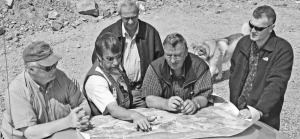VANCOUVER — The planned super pit at the revived Copper Mountain mine may have to be even bigger than designed, as the latest drilling by Copper Mountain Mining (CUM-V, CPPMF) has revealed two new mineralized zones.
One of the five drills turning at the project in southern British Columbia is testing areas of high chargeability identified in a Titan 24 deep-penetration geophysical survey. The chargeability anomalies correlate well with the project’s known mineralization. Now, the first drill hole into the anomaly underneath pit 3 has returned a long mineralized intercept.
The first intercept from hole P3-08 was 24 metres long and graded 0.53% copper, 2.3 grams silver per tonne and 0.2 gram gold from 299 metres depth; a 16.5-metre interval from 351 metres down-hole returned 0.42% copper, 1.62 grams silver and 0.02 gram gold. The interval of real interest started at 541 metres downhole: 292 metres of 0.55% copper, 2.23 grams silver and 0.14 gram gold, including 98 metres of 1.31% copper, 5.53 grams silver and 0.34 gram gold.
Judging from this initial intercept, the mineralized zone starts some 365 metres below the current bottom of pit 3. Since the mineralized zones within the pit 3 area are usually vertical, and as the drill hole had flattened to 30 below the pit bottom, true thickness is thought to be 87% of the intersected width.
Of the five drills working at Copper Mountain, only one is testing geophysical anomalies. Two others are located on the northeast wall of pit 3 to upgrade inferred resources to be exploited within the five-year pit plan, a fourth is drilling in pit 3 to provide details for mine planning, and the fifth is drilling the other newly discovered zone of mineralization.
The new zone is located just west of pit 2 and north of pit 1, where drill-hole P1-09 intersected 102 metres grading 0.52% copper, 1.43 grams silver and 0.14 gram gold starting 180 metres below the pit bottom. Other intersections from the new zone include 120 metres grading 0.69% copper, 1.71 grams silver and 0.26 gram gold in hole P2-67, and 113 metres of 1.05% copper, 2.35 grams silver and 0.28 gram gold in hole P2-92.
The zone appears to extend some 300 metres north of pit 1, with a width of 90 to 120 metres. It begins at around 60 metres depth and rakes to the southeast, generally coinciding with the northwest edge of a strong, pipeshaped chargeability anomaly.
The new zone is just beyond the western corner of the super pit designed for the preliminary economic assessment. Since drilling in the area is still widely spaced, the new zone will not be included in the feasibility study currently under way. The drill data will, of course, be included in subsequent pit designs and will likely boost the project’s resources in the near future.
The recent exploration success at Copper Mountain prompted the company to expand the planned 30,000-metre 2008 drill program to 50,000 metres.
Finding and mining copper at Copper Mountain is not new. The mine has stopped production only three times over the last 90 years and each halt was due to falling metal prices, not a lack of resources. Princeton Mining was the last company to operate Copper Mountain; it ceased operations in the mid-1990s.
Copper Mountain Mining was formed as a private company in December 2006 and drilled 44,000 metres in 2007 as well as completing the Titan survey. The company had its initial public offering in June, came out with a resource estimate in August, and completed an economic assessment by November that called for production of 1 million lbs. copper per year by the end of 2010.
The proposed super pit, a heart-shaped hole that would join the project’s three pits, would be 3.5 by 3.5 km and would allow access to mineralization at depth, which is why the latest drill result from below pit 3 has the company excited.
The project already hosts measured and indicated resources of 228 million tonnes grading 0.37% copper plus 197 million inferred tonnes grading 0.31% copper.
The report forecast processing 35,000 tonnes of ore per day to produce a copper concentrate with gold and silver credits. Much of the mine’s infrastructure is still in place, including power and water, as well as a paved public road to the mine gate, but a new milling facility would be needed. Capital cost estimates came in at $366 million.
Mineralization at Copper Mountain is classified as a bulk-tonnage, alkalic porphyry copper deposit hosted within Nicola-group volcanic rocks. The mineralized system is structurally controlled and focused at multidirectional vein intersections and within vein stockwork systems.
To advance payments on long lead-time items for the new mill and pay for infrastructure upgrades and ongoing exploration, Copper Mountain recently announced a $50-million equity offering. The junior is offering up to 21.7 million units at $2.30 apiece, with each unit comprising one share and one warrant exercisable at $3.50 for one share within 12 months.
Copper Mountain’s share price remained unchanged by the news, closing at $2.20. The company has a 52-week trading range of $1.50-2.77 and has 21.9 million shares issued.


Be the first to comment on "Copper Mountain hits new mineralization"